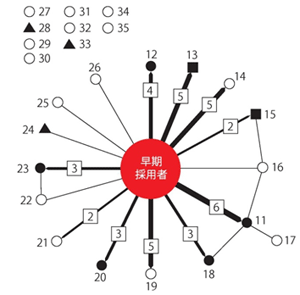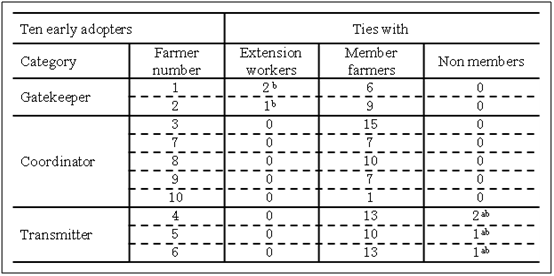Role of social network in the diffusion of water-saving irrigation technology in the Philippines
Description
A water-saving technology is required for cost reduction of deep well-irrigated rice cultivation. AWD (Alternate Wetting and Drying) is an intermittent scheme of irrigation and this method can save water up to 15-30% in comparison with the regular flooding method, although entailing additional labor for water management and weeding, rodent damage and risk of yield loss due to improper irrigation timing. Thus, transferring correct technical information is crucial for effective technology transfer. The International Rice Research Institute (IRRI) carried out a pilot project on AWD dissemination for the deep well irrigation system in Tarlac, Luzon for the period 2002-2003. However, diffusion of the technology has not progressed well after the project. Aimed at clarifying the formation of the social network regarding AWD, a farmer survey was conducted for a total of 35 members of the pilot project irrigation association from September 2006 to February 2007.
The farmer-cooperators of the project mostly understand the advantages of AWD, although some misunderstanding on technical considerations for cultivation methods, which required attention, occurred within the farmer-to-farmer communication process. If the farmers practice AWD with defective knowledge, not only yield loss but also some distrust in the leading farmers and extension workers may arise. Even if a farmer understands AWD correctly, there is such a case wherein he is too passive to communicate with other farmers, fearing that he might stand out or that any problem might occur later among neighbor-farmers who adopted AWD based on his advice. So after this project was finished, the spontaneous adoption of AWD was very limited. When we treat the ten early adopters as one actor, the network of AWD becomes a typical star-shaped network. The early adopters are located in the center and influence the surrounding farmers directly, but the network formation from these first-contact farmers to other farmers was extremely restrictive (Figure 1). The ten early adopters are categorized by position and role in the network as the following three types. The “gatekeeper" conveys technical information from the outside resource persons into the community. The “coordinator" is positioned in the center of the network, and closely tied with the community members but less with outsiders. As an opinion leader or focal person, he consults and coordinates with the community members. The “transmitter” holds a similar position to that of a “gatekeeper” between insiders and outsiders, but plays an opposite role. This person gains knowledge from community members and transfers it to outsiders (Table 1).
The communication between farmers is quick and efficient, but entails a risk of misunderstanding. Group formation involving both AWD adopters and expected adopters (showing interest but have not yet confirmed to adopt) is recommended. At these gatherings, it is necessary to clarify the remaining misunderstandings and skepticisms related to the technology among non-adopters in a relaxed friendly atmosphere.
Figure, table
-
Fig. 1. Social network of water users association related to AWD.
Each dot represents a member with a farmer number on the right. The central red large circle represents the ten early adopters (farmer numbers 1-10) who have continuously practiced AWD since 2002. Lines between the dots symbolize information flow related to AWD. Degree of AWD adoption is indicated as ● High, ■ Middle, ▲ Low, ○ None. Figures in □ indicate links to the ten early adopters.
Example: No. 12 farmer exchanges information with four early adopters. -
Table 1. Personal ties of the ten early adopters
Legend: No.1 farmer exchanges information with 2 extension workers and 6 member farmers.
a Officials of neighboring villages.
b No corresponding dots are shown in Fig. 1.
- Affiliation
-
Development Research Division
- Classification
-
Administration B
- Term of research
-
FY2006~2010
- Responsible researcher
-
YOKOYAMA Shigeki ( Development Research Division )
RODRIGUEZ Ma. Victoria C. ( International Rice Research Institute )
YASUNOBU Kumi ( Tottori University )
- ほか
- Publication, etc.
-
Yokoyama et al. (2009) Journal of Agricultural Extension Research 14(1):81-97.
- Japanese PDF


